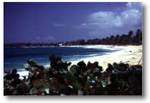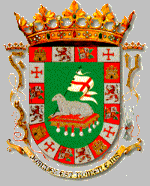Puerto Rico is the most oriental island and also the shortest of the Great Antilles, with 160 km long and 56 km wide. The official languages in Puerto Rico are Spanish and English, teaching both languages in schools. English is used frequently in business, industry, investigations and all the professions. Puerto Rico has the biggest touristic movement of all the islands of the Caribbean, because of it's beautiful sites, exotic hideaways, miles of white sandy beaches  and pleasant tropical weather all year long. In addition to natural splendors you can find yourself surrounded by warm and friendly people.
and pleasant tropical weather all year long. In addition to natural splendors you can find yourself surrounded by warm and friendly people.
Originally, the island was populated by indians from the migratory cultures of South America, which arrived at Puerto Rico through the islands of Barlovento and Sotavento. The TAÍNOS named the island BORINQUEN, these indians were pacific and religious. They were great in agriculture and learned to live with the island. Findings of recent years confirm indian population of the island in the 4th century before Christ.
In 1493, Christopher Columbus discovered the beautiful island of Puerto Rico and colonized by Juan Ponce de Leon in the year 1508. At first the island was named San Juan Bautista by its colonizers and the capital received the name of Puerto Rico, years later the spanish government decided to rename the island Puerto Rico thinking that the island was rich in gold and because of its rich ports.The capital was then renamed San Juan.
The antique city of San Juan is still conserved as it was constructed in the 1520's. Besides the absence of gold, the strategic position of San Juan in Puerto Rico, and of Puerto Rico in the Caribbean, the island became the entrance to Hispanic america. Because of its strategic importance, the spanish government constructed a series of fortifications and defensive installations to defend the island of attacks from the europeans. One of these fortifications
includes  El Morro.
El Morro.
During this time the residents of the island worked hard to create an internal economy based on the production of sugar cane, coffee and tobacco, with the work of the african slaves. In 1815, the "Cédula de Gracia", which consisted of privileges and extensive liberties on commerce, was created. A great number of immigrants arrived at the island with hope of making a fortune. To the end of the 1800's, Puerto Rico solidifies in social mater, economic, and political and is converted into an important exporting sugar colony.
In 1873 slavery was abolished. Puerto Rico was possession of Spain for more than four centuries, until the Treaty of Paris signed on November 10, 1898 which gave away Puerto Rico to the United States and gave end to the Hispanic-american War. The Jones Act of 1917 gave the residents of Puerto Rico the U.S. citizenship. For the first time in 1948, Puerto Rico had the right to choose its own governor. In 1950 the U.S. Congress approved the 1600 law, authorizing the government of Puerto Rico to redact and choose its own constitution, in harmony with the Constitution of the United States. In 1952, Puerto Rico receives the status of "Estado Libre Asociado" or Common Wealth.
The Common Wealth establishes that Puerto Ricans participate of citizenship, dollar ($), defense, and commerce with the U.S. In the other hand Puerto Ricans don't pay federal taxes, do not vote in national U.S. elections, but are represented in Washington by a Resident Comisioner.


